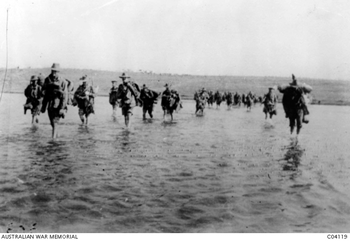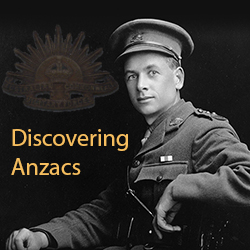Where can additional information be found to add to the story?To enhance the story of your veteran you can add maps, photos, and images of related artefacts and ephemera. Search for additional materials using a variety of search terms such as dates, unit names, names of colleagues, place names at:
|
 1st Section and 2nd Section of 1st Field Company Engineers arriving from Anzac for a spell crossing the shallow arm of Mudros Harbour towards Sarpi Camp. Lemnos, Greece. October 1915. Public domain, Australian War Memorial. |
|
|
Student presentation using Adobe Voice
Transcript: Adobe Voice student presentation
Frederick Charles Brightfield was one of the nearly 420,000 Australian men who enlisted in the First World War. [caption: Frederick Brightfield]
Born in Leichhardt, Sydney, he was the eldest of 13 children of Gertrude and Arthur Brightfield.
Fred was 25 when he decided to join the Australian Imperial Force. [caption: Fred was living in Redfern at the time.]
The AIF placed him in the 1st Field Company Engineers, as a member of the 9th Reinforcements.
In October 1915 he left Melbourne on board HMAT Port Lincoln, bound for war. [caption: HMAT Port Lincoln in convoy during the war.]
Fred was experienced with horses and transporting goods, so he was made a ‘driver’. Later he was promoted to ‘sapper’ or engineer.
Sappers built and repaired infrastructure such as bridges, trenches and roads. The work was hard and the conditions were difficult.
Fred’s company would have been vulnerable to enemy attacks and the constant threat of gassing.
As well as putting up with rats and lice, he would have seen men suffering from shell-shock and trench foot.
The company moved around battle sites and Fred saw men killed, including one of his commanders.
During 1917 his company moved between France and Belgium, mostly by train. [caption: North-west France around Ypres showing the border with Belgium.]
Once they got to Amiens they had to march for two-and-a-half hours in full kit and defend themselves along the route.
By September 1917 Fred’s company was near Ypres in Flanders. Some 38,000 Australians were killed or wounded in the battles of Ypres that year. [caption: War-torn Ypres, 1917.]
Fred was severely wounded in the thigh by gunshot in May 1918. He was treated first in France, then England, but the war ended before he could get back to his company. [caption: Fred was first treated at Le Havre hospital in France.]
Fred returned to Australia early 1919 aboard the Orca and was discharged in April.
About a year later he married Dorothy Tripcony in Sydney and they had eight children.
When the Second World War broke out Fred put his age down by five years so he could enlist.
Three of his brothers, who had been too young for the First World War, also joined up. [caption: Fred’s 18 year old daughter Freda also enlisted.]
Having served in two World Wars, Frederick Charles Brightfield died in 1973 aged 83. [caption: Frederick Brightfield 1891-1973.]
Adding depth
What other sources are available to cross reference and verify the information that I have found?
Trove is an extensive digital archive that brings together a wide variety of Australian content from libraries, museums, archives and research organisations in a database administered by the National Library of Australia. Trove provides searchable access to these materials to add and verify information which provides authentic depth and breadth to the story of your veteran.
Trove also provides access to the archives of Australian metropolitan and regional newspapers. Search by keyword across all newspapers or narrow your search to a specific newspaper. You can also search more generally for Australian newspaper articles relating to the outbreak of the war, various events and battles.
Trove also provides additional photos and images of ephemera (objects), including about the effect of events on the times and the impact of the war on the local community from which your veteran came.
NSW State Records also has an extensive collection of primary source material and information related to the First World War at Records of NSW and World War I. This provides further archives related to the themes of service, remembrance and the home front.

